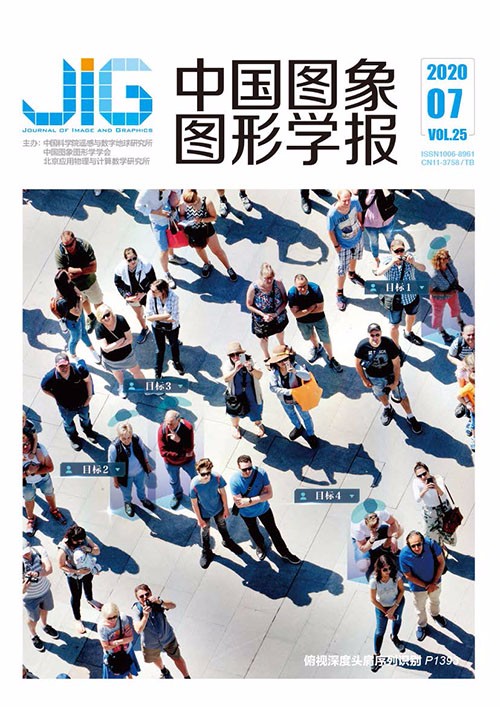
基于透射率修正的湍流模型与动态调整retinex的水下图像增强
摘 要
目的 为提高水下获取的结构物表面缺陷图像的对比度和清晰度,便于缺陷区域的分割、提取和识别工作,提出了一种基于改进的湍流模型和引导滤波平滑的retinex的图像增强方法。方法 将光照不均的水下图像转换到Lab空间,对亮度空间进行自适应直方图均衡的匀光处理,根据暗通道先验理论估算匀光图像的透射率,结合大气湍流通用模型模拟退化图像,通过调整透射率系数获得退化图像。采用维纳滤波过滤图像噪声,将滤波后的图像作为导向图,利用导向滤波细化获得边缘保持的图像。根据3σ准则对3通道多尺度retinex (multi-scale retinex,MSR)的反射分量进行色彩矫正,获取最终增强后的水下结构物表面缺陷图像。结果 选取多组在不同湍流环境下采集的图像为研究对象,采用本文提出的方法进行实验,并与经典的暗通道算法、直方图均衡算法以及单尺度retinex算法对比,使用信噪比、信息熵、标准差和平均梯度等指标进行评估。实验结果表明,本文方法的信息熵、标准差相较直方图均衡算法和单尺度retinex分别提高了11.7%和25.6%,分割准确率上升了3.1%。从主观效果上看,本文算法图像细节更为丰富,视觉效果自然。结论 本文算法改善了退化模型的自适应问题,在信息熵、标准差、平均梯度等综合指标上均有优异表现,与暗通道先验方法相比,信噪比、平均梯度大幅提升,同时实现了缺陷的边缘保持效果,为下阶段的图像处理提供了良好的信息源。
关键词
Underwater image enhancement based on turbulence model corrected by transmittance and dynamically adjusted retinex
Tang Xinyu, Li Min, Xu Lingli, Hao Zhen, Zhang Xuewu(College of Internet of Things Engineering, Hohai University, Changzhou 213022, China) Abstract
Objective The attenuation of light is typically serious even in the purest water after filtration. Experiments show that the attenuation of water is caused by two unrelated physical processes, namely, absorption and scattering. Water has obvious selectivity for light absorption, and the absorption abilities of different spectral regions vary. Such variation leads to the loss of light energy, which makes underwater imaging difficult with such phenomena as low definition and color distortion. The scattering of light by water can be divided into forward and backward scattering. The suspended particles in water cause the attenuation of light in the forward and reverse directions of propagation, which limits the detection range and distance of underwater optical imaging. This limitation results in a decrease in image contrast, blurred details, and degradation. A series of degradation problems has weakened the detection rate and accuracy of defects. Therefore, the denoising and enhancement of images with surface defects of underwater structures are significant. An improved image enhancement algorithm based on turbulence model and multiscale retinex (MSR) is proposed to improve the contrast and sharpness of surface defect images acquired underwater and facilitate the subsequent segmentation, extraction, and recognition of the defect region. The proposed method combines physical model with the nonphysical model method. Thus, this method improves the considerably simple model parameters and poor versatility. The color cast of the enhanced image is considered, and the image noise is suppressed. Method An underwater image with uneven illumination is converted from RGB space to Lab space, and histogram equalization (HE) is performed on the luminance space. After the incident light is reflected from the structure surface, it will be affected by the suspended particles from the water before it reaches the imaging device, and the scattering phenomenon will generate noise. The absorption of the spectrum by the water will attenuate the light intensity, and this condition will result in low image contrast. The process is similar to the imaging model of a foggy-degraded image. Thus, the reconstructed method of the degraded image can be used to process the blurred underwater image. The light intensity distribution in the imaged scene after homogenization is similar, which can be approximated as a fixed value. The transmittance of the homogenized image can be estimated in accordance with dark channel prior theory. It describes the medium transmission that is unscattered and reaches the light portion of the imaging system, and it is also the degree of blur at each pixel. It reflects the degree of transparency of the light source components in the scene, which indicates the extent to which the image is affected by the scattering of water. In consideration of the same degraded underwater images and remote sensing images, the two exhibit similarities in optical properties, fluid media, and external forms. The atmospheric turbulence model can accordingly be applied to simulate the degradation process of underwater images. The transmittance obtained above is combined with a general model of atmospheric turbulence to simulate an underwater degradation image by adjusting the transmittance coefficient. The image noise is filtered by Wiener filter, and the filtered image is used as a guide image. An edge-preserved image is obtained using a guide filter to refine. Image enhancement is performed in accordance with retinex theory. The MSR result is color-corrected on the basis of the 3σ criterion to obtain an enhanced underwater image. Multiple images collected under different turbulent environments are selected as the research object. The method proposed in this study is used and compared with classic methods, such as the dark channel, HE, and single-scale retinex (SSR) algorithms. The indicators of signal-to-noise ratio (SNR), peak SNR, information entropy (IE), standard deviation (SD), and average gradient (AG) are evaluated. Result Experimental results show that the IE and SD of the proposed algorithm are 11.7% and 25.6% higher than those of HE algorithm and SSR, respectively. The AG is 31.2% higher than that of HE algorithm, and the segmentation accuracy is increased by 3.1%. The oversegmentation rate is the lowest among similar algorithms. From the perspective of subjective visual effects, the image after restoration by the dark channel algorithm is rich in color and prominent in detail, but its gray value is mostly distributed in the low-gray area. Such distribution results in a low image recognition rate and an unsatisfactory segmentation effect. The visual effect of HE algorithm is the closest to the original image, but the problem that the gray scale distribution is excessively concentrated remains. The segmentation accuracy is slightly improved compared with that of the dark channel algorithm. The image after SSR shows a color cast phenomenon, and the overall gray value of the image after the dynamically adjusted MSR decreases. The range of gray scale is enlarged, and the color cast effect is improved. The color and detail of the image are the richest, and the visual effect is the most natural among all the tested algorithms. Conclusion On the basis of the analysis of an underwater image degradation model and the difference among pixels, the image transmittance is estimated, and the gray scale distribution of the enhanced image is expanded by the 3σ criterion. An enhanced underwater image with high contrast, high definition, and balanced color is obtained. The algorithm improves the adaptive problem of the degenerate model with excellent performance in comprehensive indicators, such as IE, SD, and AG. Compared with the dark channel prior method, the proposed method exhibits greatly improved SNR and AG. The edge information of the image is preserved, which provides a good information source for image segmentation and recognition in the next stage.
Keywords
underwater image enhancement turbulence model transmittance Wiener filtering multi-scale retinex(MSR) color correction
|



 中国图象图形学报 │ 京ICP备05080539号-4 │ 本系统由
中国图象图形学报 │ 京ICP备05080539号-4 │ 本系统由